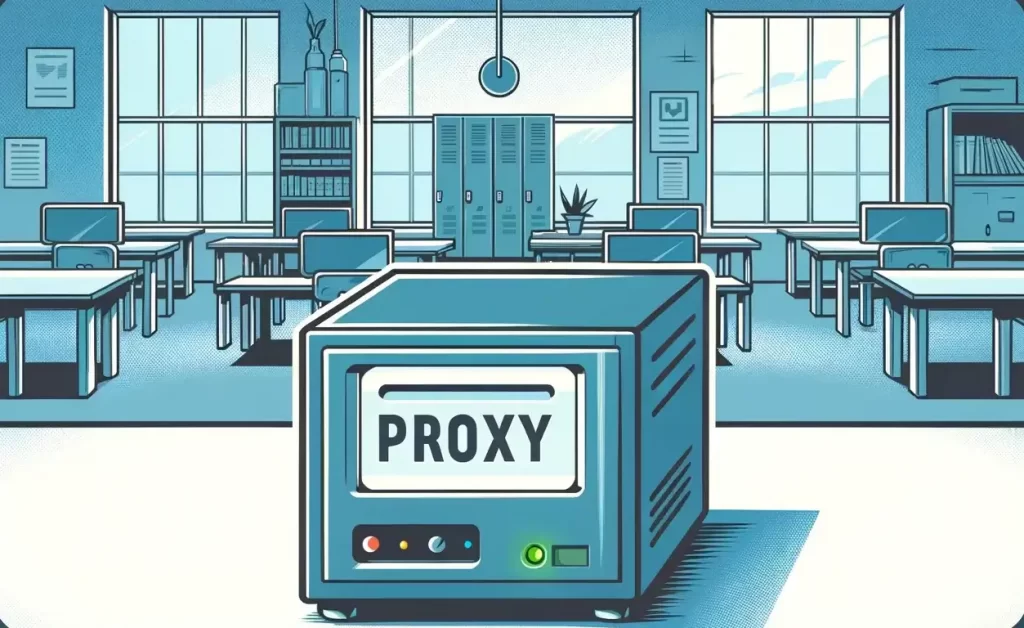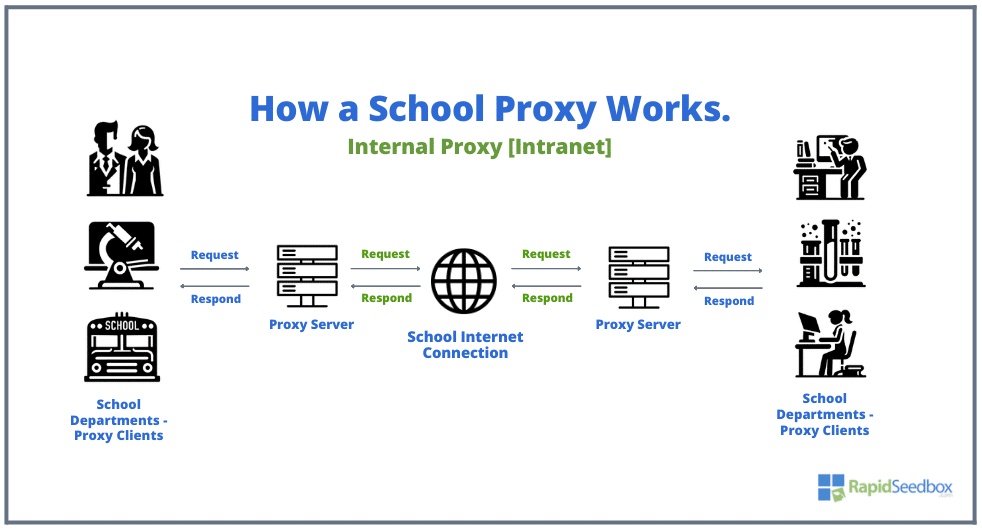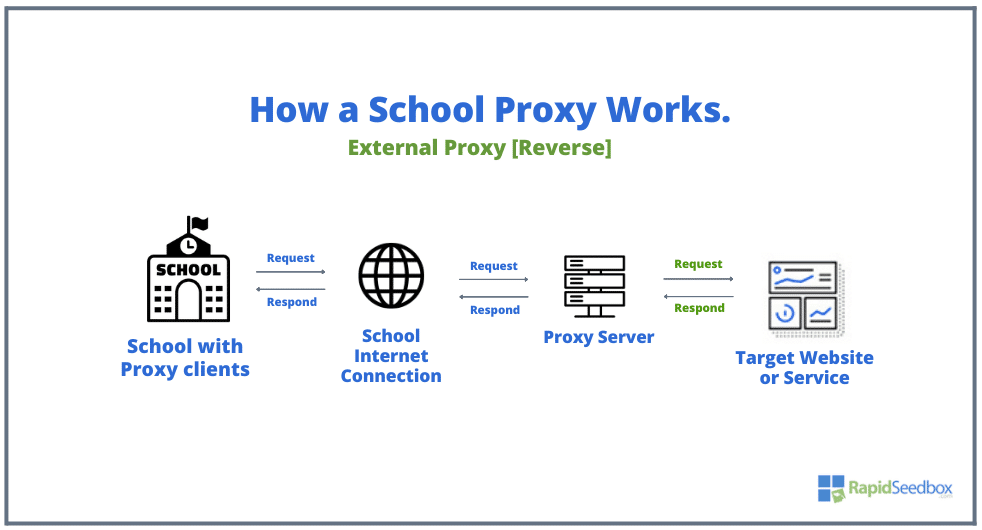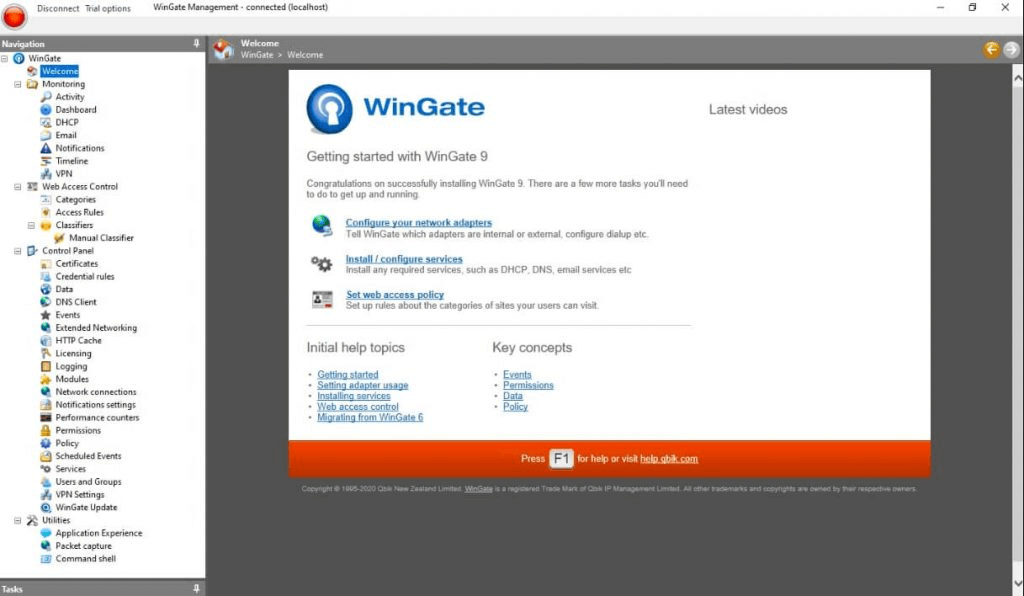School proxies are like the gatekeepers of the internet in schools. They ensure that students (and other school personnel) can browse the web safely and securely and that they don’t access any inappropriate content. School proxies also help to manage how much bandwidth students can use, which is important for keeping the network running smoothly.
In this article, we will dive deep into school proxies. We’re going to break down what school proxies are, the different kinds, the pros and cons, and how to use them. This guide is a must-read for the school’s network admins, IT personnel, and students alike!

Disclaimer: This material has been developed strictly for informational purposes. It does not constitute endorsement of any activities (including illegal activities), products or services. You are solely responsible for complying with the applicable laws, including intellectual property laws, when using our services or relying on any information herein. We do not accept any liability for damage arising from the use of our services or information contained herein in any manner whatsoever, except where explicitly required by law.
Table of Contents:
- What is a school proxy?
- How does School proxy work?
- Internal Proxies
- External Proxies
- Benefits and Risks of School Proxies
- How to Use a School Proxy
- Find the Right Proxy
- Configure Proxy Settings
- Connect and Browse
- School Proxies FAQ.
- Final Words.
1. What are school proxies?
A school proxy is an intermediary server (or a mediator) for traffic between the school’s network and the internet. Its sole mission is to protect students from accessing unwanted content by controlling and filtering internet traffic. In addition, the school proxy also protects school personnel and students by filtering IP addresses, controlling bandwidth, and promoting responsible internet use while providing privacy and anonymity.
School proxies can serve two main roles:
- Internal Proxies: These manage and filter the internal network traffic. These proxies ensure students and staff can access educational content without exposure to inappropriate materials.
- External Proxies (Reverse Proxies): These types of school proxies protect and manage access to the school’s digital online resources (i.e. professionally designed websites, web servers, etc) from external requests.
Keeping information safe in schools is a top priority, especially when it comes to the student’s personal information and the teachers’ data. Proxies can also help unblock educational websites that shouldn’t be blocked in the first place.
What is not a school proxy?
There are external proxies that students can get free (or at a price) at different sites. These proxies (not school proxies) are used by students to bypass local school network restrictions and unblock websites and even games. These proxy’s IPs are generally unknown by the school network’s admin, so they are not included in any firewall’s blocklists.
Note: The goal of a school proxy is to make a safe space where students can learn and explore without going too far and getting into trouble. A school proxy is not intended to unblock websites or games.
2. How School Proxies Work?
There are various types of proxies that can be deployed differently and for different use cases. For a school use case let’s consider “location” either internal or external (as discussed in the previous section).
a. How does an Internal School proxy work?
Let’s imagine a school, along with all its school departments (user groups), such as administration, teachers, lab, school rooms, students, guest network, etc. All these user groups (running proxy clients) connect to a central node, (the School’s Internet), through the internal proxy server. These user groups send requests to this proxy server, before going out to the internet.
This internal proxy server processes and forwards these requests to the school’s internet connection. It then, responds back to the clients. This setup helps manage internal internet access and filter content according to school policies.

b. How does an External School proxy work?
External proxy servers are also helpful in school setups. They help enhance security for external school resources (known as reverse proxies).
Refer to the following diagram. In this setup, the school’s Internet requests are external. This means, that requests are first sent to the school’s internet connection and then they are directed to a proxy server (which can be located anywhere in the world). This external proxy then processes the requests. If it is a reverse proxy protecting school resources, it will decide how to handle the external request.
If it is a simple external web proxy, it can perform various options: It can change IP addresses, anonymize traffic, and more.
Note: The reverse proxy setup is typically used for external-facing services like a school website, enhancing security and load balancing.

3. What are the benefits and potential risks of using a school proxy?
The benefits and potential risks of using a school proxy may vary from the type of proxy and its location.
Generally, the benefits are accessing restricted content, protecting online identity (privacy, security), and overall internet safety, online security, bypass filters, and network privacy. But of course, school proxies are not the perfect solution; there are some potential risks. The most common risks include legal and ethical implications.
In the following table, we delve into the benefits and potential risks associated with implementing a school proxy.
| Aspect | Pros | Cons |
| Security | Enhances protection from harmful content and data breaches. | Requires continuous updates to remain effective. |
| Content Access | Blocks inappropriate sites; allows access to educational content. | Over-filtering may block useful resources. |
| User Privacy | Masks IP addresses to protect user information. | N/A |
| Internet Safety | Ensures safe browsing for students. | N/A |
| Legal Compliance | Adheres to policies and protects against illicit activities. | Potential misuse may lead to ethical concerns. |
| Network Management | Allows for monitoring and controlling internet usage. | Needs dedicated management and resources. |
| Browsing Experience | Can improve focus by limiting distractions. | May slow down internet speed and affect browsing. |
| Educational Resources | Facilitates access to restricted academic content. | Might require bypass methods for overly strict filters. |
Stop wasting time with slow proxies. Here’s a better way!
🌐 RapidSeedbox custom proxies offer optimized IPv6 & IPv4, 24/7 support, HTTPs & SOCKS5 versatility, and global access.
————
4. How to use a school proxy?
a. Find the right School Proxy
This step depends on the type of proxy, its location, and the solution. In other words, what are you looking for? Are you a school network admin wanting to set some internet browsing policies? Or are you a teacher or student needing to unblock restricted websites for proper research?
Look for VPS Servers where you can install proxy server software.
We recommend the following proxy server solutions (each with unique capabilities and features):
- Squid, known for caching and flexibility;
- NGINX, renowned for performance and reverse proxy capabilities;
- Apache HTTP Server, which also serves as a proxy;
- HAProxy is recognized for load balancing and high availability;
- WinGate is a favorite in Windows environments for its comprehensive internet tools.
We recommend researching and choosing a reliable school proxy service that fits your needs.
For both (internal proxy and external proxy), as a reverse proxy, we recommend using an IPv6 proxy. These types of proxies (either HTTP or SOCKS5) can be used as school proxy solutions for the two aforementioned needs. We recommend these because they are clean, fast, secure, and highly affordable.
Looking for a different type of proxy?
A quick search on GitHub gives you a few reliable web proxy solutions for external usage. The following are designed to bypass internet restrictions typically found in school environments. These provide unblocked access to online content such as games and websites.
- MonkeyGG2 / monkeygg2.github.io: A gaming website with over 150 games. This repository is designed for easy deployment with a proxy for unblocked access in schools.
- Theooofficial / marinejumbopr0xy: A creatively named web proxy inspired by ANA Airlines’ “marine jumbo” livery. This solution is focused on unblocking websites in educational settings.
- Azenark / Azenark.github.io: Offers a collection of unblocked games and proxy tools. This proxy solution is aimed at circumventing school internet restrictions.
B. Configuring the proxy settings.
Depending on the scenario (whether you are deploying a server+client solution or a client-only using a third-party server provider), you’ll need to always ensure the network route from the school is correctly set up to take traffic through the proxy.
- Server & Client Deployment: Install the proxy server software. For instance WinGate. There, you’ll need to configure network settings, configure settings (DHCP, DNS, email, etc), set web access policies or rules, and more.

- Now, go back to every device and install the client software. In some cases, you’ll only need to define the proxy server’s information. If that is the case, go ahead and configure the client to connect to your server’s IP and port.
- For a full guide on implementing a proxy server, check the ultimate guide to Wingate.
- In the next section, we’ll go through the brief step-by-step to configuring the proxy settings in a client.
- Client-Only Deployment (with a third-party proxy server):
- Install proxy client software. In some cases, you’ll need to install the appropriate proxy client software. But in many others, just by configuring the proxy server details, like IP and port in the appropriate client (software) such as browsers, or other applications.
- As an example, let’s explore how to configure the proxy settings in Chrome.
- Open Chrome, click the three dots for the menu, and select “Settings.”
- Navigate to “System” and click on “Open your computer’s proxy settings.”
- In the system proxy settings, add your proxy details:
- For Windows: Enable “use a proxy server” and enter the address and port.
- For macOS: Choose a protocol, then enter the server, port, and credentials.
- Remember, these settings apply to the entire system, not just Chrome.
- To disable it, simply reverse the changes in the proxy settings of your operating system.
C. Connect and Browse.
Now, that you have either deployed the proxy server and client or hired a third-party server, and have configured your proxy clients, it is time to connect and browse.
- Connect: Establish a connection with the proxy server.
- Browse: Allow the school personnel and students to start browsing the internet through the proxy, accessing content while your traffic is routed and filtered through the proxy server. If you are using a third-party proxy to unblock restricted websites (additional resources), you should be able to browse without limitations.
- Disconnect: When finished, ensure you properly disconnect from the proxy service to resume normal internet access.
5. School Proxy FAQ
1. How do school proxies compare to VPNs?
Both school proxies and VPNs, route internet traffic. Although both have similarities, like the ability to provide privacy and content filtering, they do have differences. On the one hand, School proxies focus on content management and network control, often with more granular content filtering capabilities. VPNs, on the other hand, encrypt all internet traffic and mask the user’s IP address, so they provide superior privacy and security.
3. How are school proxies used in an educational context?
In educational settings such as universities, schools, colleges, etc, school proxies are employed to manage and filter internet content. They ensure students access relevant and safe materials. They are some of the best solutions to block inappropriate sites, limit distractions, and ensure that educational content aligns with the school’s curriculum and language requirements.
4. Can school proxies be used to unblock websites?
Yes, external web proxies can be utilized by students to bypass local network restrictions to access blocked websites (including sites and games). However, note that this is often against school policies and is not the intended use of school-provided proxies.
5. How do you manage access and requests through a school proxy?
School proxies manage access by filtering requests based on predefined rules and policies. They can allow or deny access to specific pages or websites, ensuring that the network usage aligns with educational objectives and security standards.
6. What is the role of GitHub, JavaScript, and HTML in school proxies?
GitHub can host repositories containing code for setting up and deploying school proxy servers. JavaScript and HTML can be used in the development of web interfaces for school proxies or for creating scripts that interact with the proxy. For example, developers can share code snippets or entire proxy server configurations on GitHub, allowing schools to implement or customize their proxies.
7. In what ways do school proxies contribute to education?
School proxies ensure a safe and focused online environment. They make sure that students can learn and explore online resources without getting distracted by inappropriate content or seeing content in different languages. This helps create a safe and focused learning environment where students can get the most out of their education.
6. Final Words.
Our guide to SchoolProxy went through the technical details and the various types of school proxies—internal, external, and web proxies. Understanding their importance in bandwidth management, content filtering, and online threat protection, is key.
The guide also provided the technical background on how a SchoolProxy works and its pros and cons. Additionally, it offered guidance on selecting, configuring, and effectively utilizing school proxies to meet their specific needs.
We hope the guide to school proxy was useful. If you have any doubts or suggestions, please leave your comments below.
Stop wasting time with slow proxies. Here’s a better way!
RapidSeedBox custom proxies offer optimized IPv6 & IPv4, 24/7 support, HTTPs & SOCKS5 versatility, and global access. 🌐 Check them out now!
0Comments